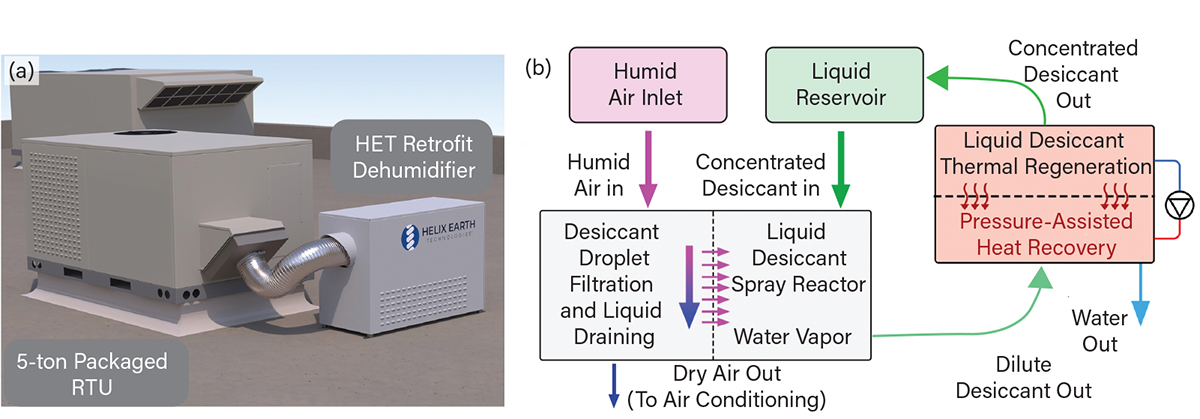Air conditioning (AC) systems contribute almost double the CO2 emissions of the entire aviation industry worldwide. Globally, approximately 1 billion commercial AC systems and 1 billion residential AC systems are in use today, according to the International Energy Agency. These air conditioners emit 2 Gt of CO2 annually, representing 4% of total global CO2 emissions. This is projected to double by 2050.
AC systems also waste a substantial amount of energy. Humidity forces air conditioners to consume more energy to remove excess moisture, driving up utility bills and accelerating system wear and tear. Wasted energy from humidity represents more than half of the energy used by AC units globally. Therefore, efficient dehumidification is key to mitigating the energy footprint of AC units.
Current dehumidification methods use solid and liquid desiccants and typically require energy-intensive operations to supply the necessary heat of vaporization to drive out adsorbed water for desiccant regeneration and reuse. A heat source is usually needed, and the reuse of waste heat presents numerous challenges and leads to higher capital and operational costs. In addition, current dehumidification methods suffer from slow process rates, resulting in bulky systems that are costly to build, ship, and install. A solution that reduces the energy intensity of desiccant regeneration and enhances dehumidification rates would significantly impact AC efficiency.
Enter Helix Earth, a start-up based in Houston, TX. With support from the U.S. National Science Foundation (NSF), the company is working on a new way to enhance AC performance with a rapid, compact, and highly efficient dehumidification process. Helix Earth’s solution is unique due to its novel liquid desiccant deployment method, which increases the contact surface area between liquid and gas by orders of magnitude. This results in a system one-tenth to one-twentieth the size of a conventional dehumidifier system, significantly reducing operating and capital costs.
The dehumidification system includes a patented spray-based dehumidification process as well as a patented desiccant regeneration process that employs a pressure swing cycle to reconcentrate the desiccant. The system evaporates water from the dilute desiccant and recycles most of the latent heat of condensation to enable highly efficient desiccant regeneration. Helix Earth’s desiccant regeneration system can potentially operate with a coefficient of performance (COP) greater than 8, which substantially surpasses the current state-of-the-art technologies.
This technology is highly appealing because it can be easily retrofitted into existing commercial and residential systems. Customers can substantially increase building efficiency with little to no modifications to their existing systems, a value proposition that has attracted considerable interest from investors and property owners. The technology has been scaled to handle 5-ton and 10-ton cooling loads.

▲Figure 1. (a) The Helix Earth retrofit dehumidifier pre-dehumidifies air before it enters the air conditioning (AC) unit, reducing latent loads and energy use. This unit has been scaled to handle 5-ton packaged rooftop AC units (RTUs), as shown here, and 10-ton RTUs. (b) A block diagram of the Helix MICRA dehumidification system shows how this system recycles the latent heat of condensation to enable efficient desiccant restoration.
By tackling AC emissions, this retrofittable technology has the potential to significantly mitigate a major source of carbon emissions. This is especially true as this technology could make cooling far more affordable in tropical countries, where the need for air conditioning is most acute. Helix Earth has garnered substantial industry excitement, with Kevin Murphy, a vice president at Hunton Group, one of heating, ventilation, and air conditioning (HVAC) solutions company Trane’s largest distributors, noting that “quick and efficient ventilation air dehumidification, like what Helix Earth is developing, is a quantum leap improvement for HVAC systems.”
This technology was supported by the U.S. NSF through the Small Business Innovation Research (SBIR) program.
This article was prepared by the U.S. National Science Foundation in partnership with CEP.

Copyright Permissions
Would you like to reuse content from CEP Magazine? It’s easy to request permission to reuse content. Simply click here to connect instantly to licensing services, where you can choose from a list of options regarding how you would like to reuse the desired content and complete the transaction.
